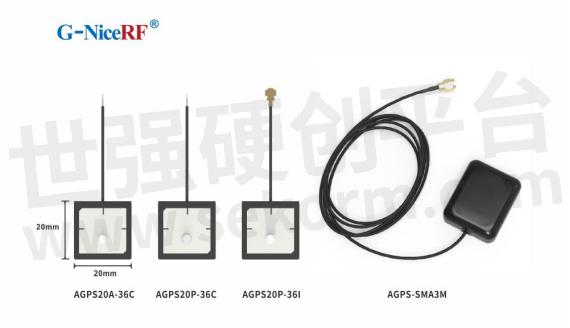Selecting the Right GPS Beidou Positioning Antenna – Tips and Performance Comparison




Selecting the Right GPS Beidou Positioning Antenna – Tips and Performance Comparison
Multi-system Compatibility: Ensure that the antenna can receive not
only BeiDou signals but also signals from other GNSS systems (such as
GPS, GLONASS, and Galileo) to enhance positioning accuracy and
reliability.
Signal Frequency Selection: Choose the appropriate
signal frequency band based on application requirements. The BeiDou
system offers multiple frequency bands (such as B1, B2, B3), and
different frequency bands may perform differently in various
environments.
Antenna Gain: Choose an antenna with
appropriate gain. High-gain antennas are suitable for scenarios
requiring long-distance or high-precision positioning but may introduce
more interference in strong signal environments.
Interference
Sources: Stay away from strong electromagnetic interference sources,
such as high-power radio transmission equipment and electric motors.
Interference sources can introduce noise into the signals received by
the antenna, affecting positioning accuracy.
Antenna
Orientation: Ensure that the antenna is facing the sky and remains
vertically upright. The orientation of the antenna directly affects
signal reception quality, and incorrect orientation may lead to unstable
signal reception.
Cold Start, Warm Start, and Hot Start Methods for GPS Module
Cold Start refers to restarting the GPS receiver from a completely powered-off state or after it has not been used for an extended period. The receiver needs to search for and lock onto satellite signals from scratch.
Warm Start refers to restarting the GPS receiver near the last shutdown location, with the time elapsed since the last positioning not exceeding a certain threshold (usually within a few hours).
Hot
Start refers to restarting the GPS receiver near the last shutdown
location, with the time elapsed since the last positioning being very
short (usually not exceeding a few minutes).
This start method involves some pre-start preparations, such as saving and closing necessary data through software, before restarting.
The NiceRF GPS multi-mode satellite positioning and navigation BeiDou module has a cold start acquisition sensitivity of up to -148dBm, allowing the receiver to capture satellite signals from a completely powered-off state without any prior assistance data. The tracking sensitivity reaches up to -162dBm, enabling the receiver to maintain the ability to track these signals even after they have been captured and locked, even if the signals are very weak.
The difference between an active GPS antenna and a passive GPS antenna
An active GPS antenna requires an external power supply to provide the necessary power for the antenna amplifier. The active GPS antenna integrates an amplifier within the antenna itself, which can enhance the reception sensitivity and stability of satellite signals, thereby improving positioning accuracy. Active GPS antennas are usually more complex than passive antennas but perform better in applications requiring higher performance. They are therefore suitable for use in environments with weak signals or where long-distance transmission is needed.
A passive GPS antenna does not require an external power supply to receive satellite signals. It primarily consists of antenna elements and an antenna amplifier to receive and amplify the weak signals from satellites. Passive GPS antennas are typically smaller in size and have lower power consumption, making them suitable for situations where antenna performance requirements are not very high.
How to distinguish between an active GPS antenna and a passive GPS antenna
Appearance Features: An active GPS antenna is usually larger than a passive GPS antenna because it needs to accommodate amplifiers and other electronic components. A passive GPS antenna is relatively simpler and smaller in size.
Interface
Design: An active GPS antenna typically requires an external power
cable, while a passive GPS antenna only needs to connect to a signal
cable.
Performance:
An active GPS antenna generally outperforms a passive GPS antenna in
terms of signal reception sensitivity and interference resistance,
making it suitable for applications that require high positioning
accuracy.
Application
A passive GPS antenna is suitable for applications with low antenna performance requirements, such as car navigation systems and smartwatches.
An
active GPS antenna is suitable for scenarios requiring high positioning
accuracy or environments with weak signals and significant
interference, such as precision agriculture and aerospace.
Types of NiceRF GPS BeiDou Positioning Antennas
AGPS20A-36C : High gain GPS active antenna
AGPS20A-36C is a built-in active antenna specially designed for GPS L1 and BD2 B1. The antenna consists of ceramic antenna and RF coaxial cable.
AGPS20P-36I : 1575.42 MHz GPS passive antenna
AGPS20P-36I is a 1575.42 MHz GPS passive antenna designed for GPSL1 frequency bands and Glonass frequency bands. It can be widely used in car navigation, positioning tracking, security equipment, driving recorder and other occasions. The antenna consists of microwave ceramic dielectric antenna and RF coaxial cable. The antenna has the characteristics of high gain and wide main lobe beam.
AGPS20P-36C : High gain GPS passive antenna
AGPS20P-36C is a GPS passive antenna designed for GPSL1 frequency bands and Glonass frequency bands. It can be widely used in car navigation, positioning tracking, security equipment, driving recorder and other occasions. The antenna consists of microwave ceramic dielectric antenna and RF coaxial cable. The antenna has the characteristics of high gain and wide main lobe beam.
AGPS-SMA3M : Waterproof GPS Antenna
This is a antenna specially designed for GPS frequency band , which can be widely used in vehicle navigation, positioning and tracking, security equipment, driving recorder and other occasion.
- |
- +1 赞 0
- 收藏
- 评论 0
本文由Natalia转载自G-NiceRF Official Website,原文标题为:Selecting the Right GPS Beidou Positioning Antenna – Tips and Performance Comparison,本站所有转载文章系出于传递更多信息之目的,且明确注明来源,不希望被转载的媒体或个人可与我们联系,我们将立即进行删除处理。
相关推荐
选择正确的GPS北斗定位天线——北斗GPS天线使用技巧与性能对比
本文将从北斗GPS天线使用中注意的问题、GPS模块冷、温、热三种不同启动方式等几个方面去讲述如何选择正确的GPS北斗定位天线及北斗GPS天线使用技巧与性能对比,希望对各位工程师有所帮助。
AGPS-SMA3M 产品规格书
描述- AGPS-SMA3M是一款针对GPS频段设计的带引线防水天线,适用于车载导航、定位跟踪、安防设备、行车记录仪等领域。该天线具有高增益、低噪声系数、宽频带等特点,并具备良好的环境适应性和防水性能。
型号- AGPS-SMA3M
What Are The Application Scenarios Of GNSS Positioning Module?
SKYLAB mainly has a single-frequency GPS positioning module, RTK GNSS positioning module, and antenna-integrated GNSS G-mouse finished products. This article introduces the outdoor positioning application scenarios of the GNSS module.
Smiths Interconnect 线缆组件选型指南
目录- Company and product introduction Cable Semi-Rigid/Conformable/Flexible Cable Semi-Rigid Low Loss Cable MIL-C-17/RG Series Cable LMR Cable Cable Assembly Options Cable Application Notes Cable Engineering Data Introduction
型号- RG405,402TP,RG401,LMR-240,RD316,RG402,405TP,SMS-RG142_-18.0-SMS±2.8PS,LMR-240-LLPL,LMR-400,250TP,LMR-400-LLPL,AL250LLTP,LMR-400-UF,LMR-100A-PVC,SF316,LMR-240-DB,AL141LLSP,BJ085,LMR-400-DB,142D,BJ141,LMR-195,RG316,KMS-AL141LLSP_-12.0-KMS±2.8PS,SF 142,LMR-240-UF,AL141TP,BJ047,SMS-BJ085-18.0-SMR±2.8PS,SMS_100_24.0-SMS_,AL085TP,RG223,316D,RG400,AL085LLSP,RG142
Introduction of the Functions and Characteristics of GPS Module GPS01, GPS Antenna AGPS25P-60C
On November 7, 2020, NiceRF will conduct system training for new GPS module GPS01 and GPS antennaAGPS25P-60C. The participants include our company’s business and promotion personnel. The purpose is to allow employees to understand new products more quickly and better Customer service, expand related business.
GPS模块的天线有哪些分类?
GPS便是通过接收卫星信号,进行定位或者导航的终端。而接收信号就必须用到天线。本文介绍GPS模块天线分类。
AT600扼流圈天线
描述- AT600 Choke Ring Antenna是一款高性能的阻圈天线,支持多种卫星导航系统,包括GPS、GLONASS、北斗、Galileo等。该天线具有高增益、高精度、高可靠性等特点,适用于陆地测量、精准农业、变形监测、CORS等GNSS应用。
型号- AT600
AGPS-SMA3M GPS天线产品规格
描述- 本资料介绍了AGPS-SMA3M天线,这是一款专为GPS频段设计的天线,适用于车辆导航、定位跟踪、安全设备、行车记录仪等多种场合。资料详细描述了该天线的特性、相关参数、机械和环境规格。
型号- AGPS-SMA3M
Anti-interference, Low Power Consumption, High Precision Multi-mode Satellite Positioning Technology, Bringing You a Brand New Precise Experience
The GPS02-UBX is a quad-mode satellite navigation GPS module with high anti-interference capabilities and low power consumption. The module supports multiple satellite frequencies and can be connected to either active or passive antennas.
9001002 GPS L1和L2陶瓷贴片天线规格书
描述- 该资料介绍了KYOCERA AVX生产的GPS L1 & L2陶瓷贴片天线。这种天线支持GNSS系统、全球嵌入式系统和卫星定位系统,适用于各种连接设备应用。它具有高增益、高效能和低回波损耗等特点,旨在满足设计人员对精度农业或大地测量定位等应用的严格要求。
型号- 9001002
思为无线高增益GPS/北斗无源天线系列主瓣波束宽,驻波比≤2.0,专门针对GPSL1频段和GLONASS频段设计
思为无线推出GPS/北斗无源天线系列:AGPS15P-45C、AGPS20P-36C、AGPS20P-36I、AGPS20P-50I。此系列是专门针对GPSL1频段和GLONASS频段设计的内置无源天线,可广泛应用于车载导航、定位跟踪、安防设备、行车记录仪等场合。
What is UWB Application
UWB technology is gradually becoming an essential component, akin to GPS, Wi-Fi, and Bluetooth, and has become a critical element in consumer, automotive, and industrial applications. G-NiceRF has developed products including UWB3000F00 and UWB3000F27, along with supporting antennas such as the UWB built-in FPC antenna, providing comprehensive solutions for diverse application scenarios.
Introduction to Several Common Antennas for Wireless Communications
Antennas are crucial for wireless modules. Suitable antennas can optimize the communication network and increase the range and reliability of communication. The selection of antennas has a great impact on the data communication of final module. The article introduces several antennas from G-NiceRF Company.
Distinguishing Between Active GPS Antennas and Passive GPS Antennas
Active GPS antennas and passive antennas are two common types of antennas found in GPS receivers, each with significant differences in functionality and structure. In this article Kinghelm will provide a detailed introduction.
电子商城
服务
提供7~27寸工控机定制,支持嵌⼊式/ 壁挂式 /桌⾯式/悬挂式等安装方式,采用纯平⾯板IP65防尘防⽔等级,莫⽒7级硬度触摸屏,兼容多种操作系统:组态软件/安卓/XP/win7/8/10/Linux等,支持主板、接⼝、外观、⽀架、刷卡器、⾝份证阅读器、LOGO、⻨克⻛、系统、电池、蓝⽛、4G/5G、摄像头、GPS系统、⼆维码扫描器、指纹等特殊应⽤场景定制
最小起订量: 1台 提交需求>
可定制卫星定位天线协议:GPS、北斗、伽利略 (Galileo) 、格洛纳斯(GLONASS)卫星定位;增益:5~25dBi;驻波比:≤1.5;接口连接器:IPEX:1~5代IPE、SMA接口/公头等。
最小起订量: 1000 提交需求>
































































































































































































登录 | 立即注册
提交评论